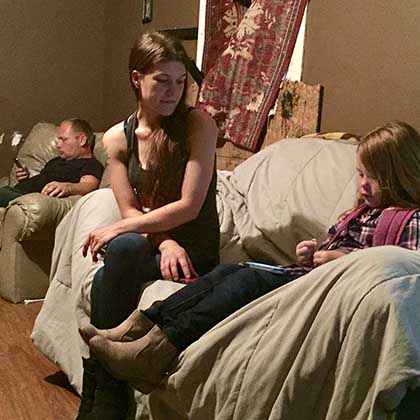United States
‘It is what it is’
Married at 16 to a man nearly as old as her father, a teenager builds a loving relationship that has lasted for eight years.
Dyersburg, Tennessee, USA A few years ago, a gas explosion destroyed Katie Burns’ house. Gone were her wedding photos, although they would have been hard to distinguish from others of her at age 16. She wore a shirt and jeans rather than a wedding dress. There were no flowers.
She was marrying Ben Burns, who at 30 was almost twice her age. She was what is commonly called a child bride.
A few years after the wedding, Katie still doesn’t have physical proof of her marriage to Ben because, she says, “my sister stole my wedding ring.”
To the United Nations and the U.S. State Department, Katie is a victim of human rights abuse. But what she did was perfectly legal and not uncommon in the Midwestern state of Missouri, where the marriage took place, just over the border from Dyersburg in northwest Tennessee, where she lives.
More than 78,000 children in the United States are, or have been, married, according to a new report by the UCLA Fielding School of Public Health.
Missouri was then a common destination for child marriages because the state had no minimum age requirement. Only those younger than 14 needed a judge’s approval. In 2018, the state raised the minimum marriage age to 16. Tennessee still does not permit 16-year-olds to marry.
Katie’s mother, Evelyn Montgomery, signed the marriage license only because Katie was pregnant with Ben’s child. Since she was younger than 18, Ben could have been charged with statutory rape of a minor.
“I told my mom, ‘What am I going to do with a baby, and he’s in jail and I have no job?’” she explains.
To Evelyn, marriage wasn’t the best solution.
“But I felt at the time, it was the only option,” she says.

“I don’t care what anybody thinks. I love him.”
Ben Burns, left, was 30 when he married Katie, center, who was 16 and pregnant. She married him so he wouldn’t be sent to prison for statutory rape of a minor. After seven years, they remain married and are raising Zena, 6, and Ben’s 18-year-old-son from another marriage. (Photo by Carolyn Presutti for VOA News)
“I don’t care what anybody thinks. I love him,” Katie declares. The marriage has lasted for eight years. “It is what it is.”
Katie kiddingly admits her husband is nearly as old as her father. And she’s only five years older than his son from a previous marriage, who lives with them in a yellow frame bungalow along the railroad tracks on the outskirts of town.
From school bus to wedding
Fifteen-year-old Ashley Duncan was in her first year of high school in rural Steele, Missouri, and sitting on a school bus when her aunt came on board and told her, “Get off, Ashley, you’re getting married today.” Like Burns, she was pregnant.
But she did not want to marry the 18-year-old father.
“When the preacher was talking, and I’m supposed to say ‘I do,’ I said ‘I guess,’” Ashley says.
Neither she nor her husband finished high school. They fought a lot and eventually separated.
“When you’re young, you tend to believe people when they say they love you. And you tend to listen to people when they tell you to do things,” she says.
Ashley loves her two sons, ages 8 and 9, and is raising them along with her boyfriend’s two sons, ages 5 and 6. She’s been separated from her husband for years but isn’t able to afford a divorce until he agrees to pay half the cost. Ashley wishes someone would have warned her about the consequences of underage marriage.
“Now, I feel like I wasted so much of my life, and it really didn’t have to happen,” she laments.
Both girls lost their childhoods. Katie says she misses playing softball and not having a care in the world. Ashley misses sleepovers with her friends.
“After I got married, friends didn’t really come around anymore,” she says.
Lost childhoods
Both Katie and Ashley were married at the Pemiscot County Courthouse in Caruthersville, Missouri, a city of fewer than 7,000 people. Caruthersville is located in an area of southernmost Missouri called the Bootheel because of its shape. The Bootheel, one of the poorer parts of Missouri, borders on three states, making it a destination for child weddings.
Before they passed a tougher law in 2018 (the minimum age is now 16), Missouri had no conditions on 15-year-olds getting married, and required anyone younger than 14 to get a judge’s permission. Now, if one person is younger than 18 and the other is 21 or older, the state won’t issue the couple a license.
County recorder Pam Strawbridge signed many marriage licenses in her 40-year career and hated to sign the ones she said were for “babies.” Strawbridge says her signature is on the union of at least one 13-year-old who came to Missouri to be married.
“I just don’t think they are experienced enough. And they just don’t know marriage is supposed to be a lifetime thing,” she says.
Ending the cycle
Katie and Ben Burns have a house filled with dogs, cats and even a potbellied pig. The couple’s spirited daughter, Zena, is now in first grade. Early marriage is not among the Burns’ dreams for her.
“I should have waited,” Katie says. “You really do need to be 18, in my opinion. You need to be grown up.”
Child marriage rates in the United States
| 2 | 4 | 6 | 8 | 10 |
